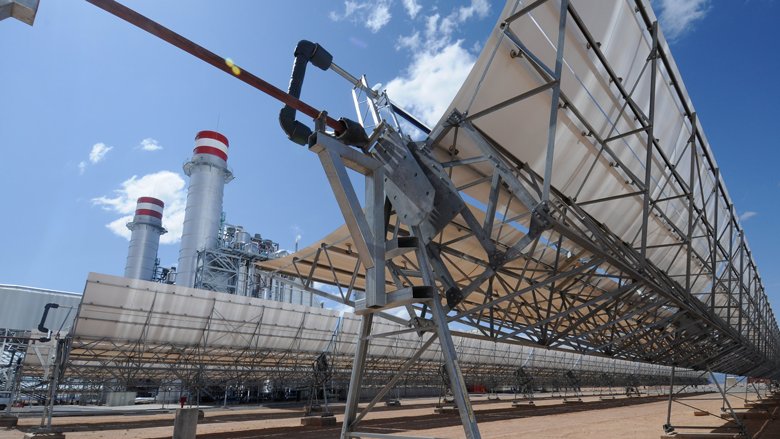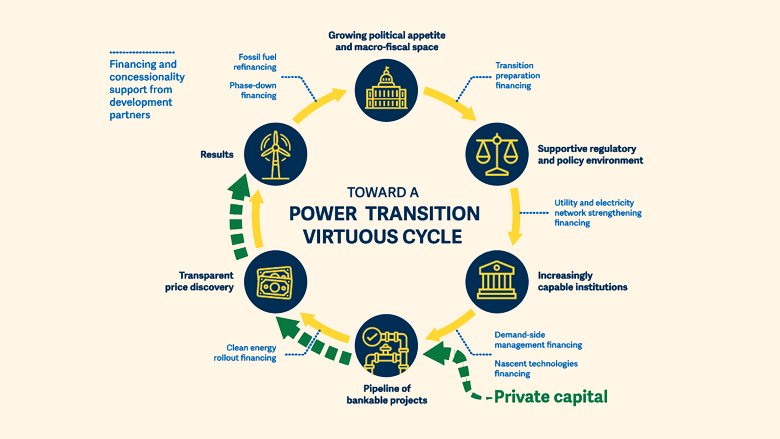In Morocco, it started in the early 2000s with the creation of a dedicated state-owned agency (MASEN) seeking to support the development of large-scale renewable generation, which in time led to the World Bank's support in leveraging multiple sources of concessional and non-concessional financing to scale up solar. The private sector has subsequently invested in hundreds of megawatts of low-cost solar generation in the sun-drenched country, which is now seeking investment for onshore and offshore wind power as well.

Ain Beni Mathar Integrated Combined Cycle Thermo-Solar Power Plant.
Photo: © Dana Smillie / World Bank
STORY HIGHLIGHTS
- Developing countries face a triple penalty when transitioning to clean energy: They often pay more for electricity, cannot access clean energy projects, and are locked into fossil fuel dependency.
- The World Bank's new framework, "Scaling Up to Phase Down" outlines how to overcome barriers paralyzing the energy transition, distilled into a six-step "virtuous cycle" for clean energy investment.
- Scaling up renewable energy and energy efficiency requires larger volumes of affordable—often times concessional—sources of finance to catalyze the process and strengthen sector foundations that can then attract the unprecedented levels of private finance needed.
We have reached our original target of 40 percent of installed capacity based on renewables by 2021, and the first 40 percent were the most painful—the next 10 percent would be easier to reach.
Minister Benali estimates the next stage of the energy transition in Morocco will take roughly $1 billion in consistent investment, mostly from the private sector.
Successes like Morocco's are reflected in a 6-step cycle outlined in the new World Bank paper Scaling Up to Phase Down, that intends to bridge the understanding between developing countries and international partners of the challenges facing developing countries to scale up renewables and phase down coal-fired power.
A 6-step virtuous cycle to accelerate the energy transition
The clear and coordinated support for transition outlined in the paper will help low- and middle-income countries overcome major hurdles in the transition. The magnitude is unprecedented: An estimated $1 trillion a year in investment just for the power sector is needed by developing countries to meet climate goals. These countries are simultaneously trying to support rising energy demand, and to do so reliably, affordably, and securely.
The transition is hobbled by a high cost of capital, with impacts that ricochet across the energy system. "Poorer countries are stuck in a vicious cycle where they pay more for electricity; cannot afford the high upfront cost of clean energy; and are locked into fossil fuel projects. In essence, they are paying a triple penalty for the energy transition," said Demetrios Papathanasiou, Global Director of Energy and Extractives at the World Bank. "The poverty trap is becoming an energy trap that is becoming a climate trap."
The cycle starts with government leadership, which is translated to a supportive regulatory and policy environment, increasingly capable institutions, and instruments to minimize risks, followed by transparent and competitive project allocation, which can deliver clean energy that serves immediate imperatives, including energy security, energy affordability, and jobs.
A strong governmental commitment is key
To get the virtuous cycle started, governments need the support of low-cost and concessional climate finance to prepare the transition, strengthen their electric utilities and networks, and then realize a pipeline of affordable clean energy investments. The initial stages of the cycle are critical and signal to investors that the country is ready for larger flows of private capital to sustain the clean energy scale up.
A strong public sector will enable a strong private sector—the two go hand in hand. When you have a more enabling environment, that reduces the cost of capital and makes it easier for the private sector to come in.
In many World Bank client countries, the energy transition risks being paralyzed by weak governance, poorly targeted subsidies, and inadequate capacity and planning. The report frames clean energy scale up as part of the solution. Clean energy can insulate utilities from price fluctuations and eliminate the need for inefficient subsidies, helping to turn around the sector and create fiscal space.
Phasing down coal hinges on scaling up renewables
The Scaling Up to Phase Down approach recognizes that only by scaling up to provide affordable and resilient clean energy will it be politically and financially feasible to phase down coal-fired power. The approach also identifies solutions like refinancing coal plant liabilities to move retirements dates forward, and the minimization and management of stranded asset risks through planning and clear policy, and the importance of preparing just transition frameworks for workers and communities that will be impacted by transition of the power sector.
Failure to act with urgency risks locking the world into a path with dangerous consequences for climate and development. All hands must be on deck to help developing countries through their energy transition.
As for Morocco, Minister Benali said that she is confident the country will reach its target of 52 percent installed capacity of renewable energy by 2030 because successful projects are propelling new investment—which is the crux of the virtuous cycle.
"The energy transition is not a luxury; it is a necessity," she says. Transitioning to clean energy is a long and complicated path, but the benefits can be achieved step by step.

